The closing circuit mechanism of a VCB (Vacuum Circuit Breaker) is a crucial part of its operation. Let’s explore how it works:
When it is necessary to close the VCB circuit breaker and allow the flow of electricity, the closing circuit mechanism comes into play. It involves a control circuit that activates an electromagnet or a spring-charged mechanism. When the control circuit receives a signal to close the circuit, it energizes the electromagnet or releases the stored energy in the spring.
The energized electromagnet generates a magnetic field that attracts the moving contact towards the fixed contact, effectively closing the circuit. In the case of a spring-charged mechanism, the released energy rapidly moves the contacts together, closing the circuit.
This swift and precise operation of the closing circuit ensures a reliable and quick response of the VCB circuit breaker, enabling it to interrupt the current flow and protect the electrical system from faults and overloads. The use of vacuum as an arc-extinguishing medium in the VCB further enhances its performance and makes it suitable for various medium-voltage applications.
In conclusion, the closing circuit mechanism is a fundamental aspect of VCB circuit breaker operation, allowing it to efficiently and safely control the flow of electricity in electrical systems.




